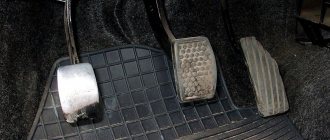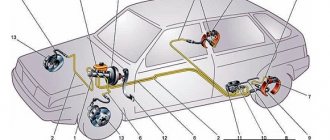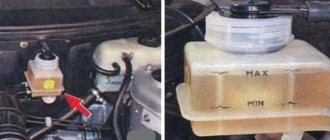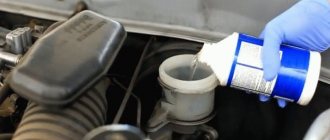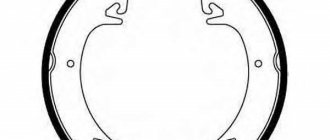Design
Why does the brake pedal sink after replacing the brake pads? The reason should be sought in the system itself, and for this it is necessary to understand its structure. In simple terms, it consists of a brake master cylinder with a vacuum booster, which is driven by a pedal. It increases the pressure in the main pipe and hoses, as a result, the fluid forces the brake system to work. In practice, the system includes pressure regulators (sorcerer) and ABS.
The fluid in the brake system is constantly under pressure. If it decreases, the pedal becomes soft or fails completely. This usually happens when there is depressurization or a decrease in the amount of liquid in the system. Let's look at several reasons why the pedal goes to the floor after repair.
Inattention
.
As a rule, many problems after repairs arise due to sloppiness, inexperience or crooked hands. Everyone knows that you cannot press the pedal with the pads removed. But, sometimes someone in the park still presses it. In this case, the brake wheel cylinders are simply squeezed out of the caliper. In this case, fluid leaks and air can also enter the system. As a result, after assembly the pedal goes to the floor; if there is a fluid pressure sensor, the warning lamp will indicate a malfunction. Damage to the cylinders
. The working cylinder has a special rubber cuff that prevents fluid from leaving it and air from getting inside. In some cases, when replacing pads, this structural element can be damaged. This will lead to fluid leakage (depressurization). In this case, the pedal will constantly fail, or it will “go away” periodically. If there is a fluid leak, you can see streaks on the wheel parts.
Reducing the amount of fluid
.
During some types of work, brake fluid may decrease. When it reaches a certain level, the pedal will begin to fail. On older car models, brake cylinders can become sour and jam. In this case, they are being developed. To do this, open the bleeder fitting and use a pry bar to press the piston into place. Next, the pumping is stopped, the brake is depressed, and the action is repeated. It is necessary to do this exercise several times until the pads return normally to their original position. This is where they make a mistake. After finishing work, they forget to check the fluid level, and it leaves the system through an open pump. If you do not make up for the loss, the pedal will move away when pressed. Incorrect assembly
. Returning the pedal to its original position is ensured by physical laws. The main part of the work is performed by the master cylinder piston; it creates a vacuum in the system, and the liquid is distributed throughout it, reducing the pressure. An auxiliary element is a spring mounted on the caliper. If you don't install it or do it incorrectly, then most likely you will get a reluctant pedal.
The brake pedal falls
There are several possible reasons for increased pedal softness, and the most common is air penetration into the brake system. Air may get in due to insufficient brake fluid level. To remove air, the brakes must be properly bled.
Pedal softness
It can also be caused by malfunctions of the master or working brake cylinders, for example, due to boiling of the brake fluid or jamming of the pistons.
Regardless of whether the brake pedal has become hard or soft, this should immediately alarm any driver; continuing to drive such a car means endangering not only yourself, but also those around you. And if it is not possible to fix the breakdown on the spot, it would be right to contact the nearest car service center.
How to identify the cause?
If the brake pedal sinks to the floor, the problem should be identified and corrected as soon as possible. The first thing to do is look at the fluid level in the expansion tank. This is the main reason for "bad" pedal behavior. But it’s not enough to add brake fluid; the brakes should be bled.
But, before pumping, be sure to determine why the fluid level has decreased. To do this, carefully inspect the calipers and drums. There should be no liquid leaks on them. If they are present, then the rubber seals may be damaged. For some models they can be changed, but this is not always possible. If the cylinders cannot be repaired, then new ones should be installed. At the same time, inspect the caliper for proper assembly.
Sometimes, a fluid leak has nothing to do with replacing the pads and is just a coincidence. If inspection of the caliper does not reveal a problem, then it makes sense to check the condition of the hoses and tubes through which the brake fluid is supplied. All damaged elements must be replaced.
What to do if the brake pedal fails after replacing the pads
If, after replacing the car's brake pads, the brake pedal fails when pressed, you need to immediately fix this problem. Inspect the calipers and drums for brake fluid leaks. When they are discovered as a result of the inspection, it is necessary to check the safety of the rubber seals of the elements. If they become dry or torn, they will need to be replaced. If replacing the seals is not possible, the part will have to be replaced.
Please note: It is a common situation when, after replacing the pads, technicians without experience assemble the calipers incorrectly, which leads to a decrease in the brake fluid level.
When it is not possible to detect a problem directly in the elements with which the technician worked, you need to look for ruptures, cracks and other damage to the hoses and tubes through which the brake fluid moves. It is possible that the problem is not related to replacing the brake pads.
Having identified the problem and eliminated it, it is necessary to compensate for the lack of brake fluid in the reservoir by topping it up. When the brake fluid is filled, be sure to bleed the brakes, otherwise the problem will not be solved.
( 441 votes, average: 4.55 out of 5)
The starter turns for a long time when starting the engine
Injectors: how to check and clean without removing them from the engine
Related Posts
Bleeding the brakes
If the tightness of the system is compromised, for example, when working on replacing hoses or developing soured cylinders, then it is necessary to pump it to remove air from the system. Pumping is carried out in the following order:
- Rear right wheel;
- Rear left wheel;
- Front right wheel;
- Front left wheel.
To work you will need an assistant.
He quickly presses the pedal 5-7 times and holds it in the down position. At this time, you loosen the bleeder fitting and allow the liquid to come out of it. It is recommended to put a transparent tube on the fitting so you can see the air bubbles escaping. Work continues until air stops escaping and the pedal becomes hard enough. All these actions are carried out on all wheels in the order indicated above. Conclusion
. As a rule, a problem with brakes does not escape any car enthusiast. In some cases, people wonder why the brake pedal fails after replacing brake pads. The reason here is air entering the system, or a decrease in the amount of liquid. Usually, this is a consequence of the driver’s inept actions during repair work. It is necessary to identify and eliminate the cause of the leak, as well as properly bleed the brakes.
Do-it-yourself brake bleeding
The failure of the brake pedal in VAZ cars can be overcome by carrying out the process of bleeding the system.
Before you start bleeding the brake system, you need to study the car's instructions, which contain a clear bleeding scheme. If there is no such scheme, then the wheels are pumped from right to left (rear right and left, then the front ones in the same way).
You also need to prepare the following necessary elements: a hose and any plastic or glass container.
The work progresses like this:
- Brake fluid is poured into the master cylinder;
- The brake pipe fittings are cleaned;
- Brake fluid is added to the container, into which one end of the hose is inserted. The other end is inserted into the fitting;
- An assistant is brought in to press the brake pedal several times and hold it down. At this time, you need to unscrew the fitting and check the liquid that leaks out. When the system is aired, air bubbles may be noticeable;
- Next, the fitting is tightened and bleeding continues with three wheels, which should be pumped according to this scheme.
Drivers must pay close attention to their “iron horse” and periodically carry out diagnostics and quality maintenance. First of all, this concerns the braking system. Checking it regularly will make it possible to avoid such troubles as the brake pedal sinking.
A serviceable and efficient braking system of a car is a guarantee not only of road safety, but also often the safety of the life of the driver, passengers and pedestrians. And one of the signs of serious problems for the car and its owner is a situation when the brake pedal fails. This process can occur either slowly or quickly. It happens that a recessed pedal does not return to its place at all. In any case, all of the above signs are a reason for serious diagnostics of the brake system. However, first you should find out what caused the emergency situation.
What to do if the brake pedal fails
- Experts believe that symptoms that foreshadow problems with the adequate “behavior” of the brake pedal are:
- increasing its stroke;
- “sticking” of the pedal in the lower position;
- unstable pedal operation;
- the appearance of extraneous noise (creaking, grinding, hissing, knocking, etc.)
Causes of brake pedal failure
- A sharp drop in the level of brake fluid in the vehicle reservoir. In addition, the quality of the brake fluid used has a fairly large influence on the functioning of the brake pedal. Counterfeit brake fluid initiates swelling of brake hoses, delamination of their inner surface and, as a result, swelling of the cuffs of the master brake cylinder (hereinafter referred to as the brake master cylinder).
- Failures and malfunction of the GTZ. This is one of the most technically difficult problems, since in this case the entire assembly has to be changed.
- Consequences of incorrect replacement of brake components (brake pads, brake discs, etc.). Abnormal behavior of the brake pedal can be observed during the period of running-in of new elements, however, a violation of the “stiffness”, jerking and “beating” of the brake pedal is a direct indication for urgent diagnostics.
- Corrosion of the brake pedal or rods connected to it.
- Damage to the integrity of the accelerator pedal sensor.
- Incorrect adjustment of the gap between the pedal rod and the turbocharger. This is checked by gently pressing it with your hand. The absence of a change in the smoothness of the pedal indicates a discrepancy between the gap size and the established operational requirements.
- Failure of the vacuum pump or leakage of the hoses (cracks), which causes air to enter the brake system circuit.


